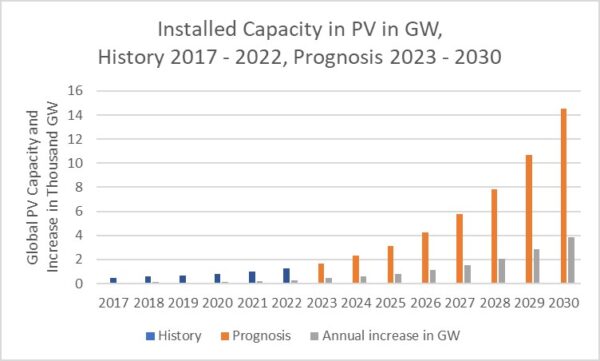From pv magazine Global | Opinion & Analysis
Energy-transition forecasts have regularly fallen short in the past. The global change in energy supply is taking place faster than expected but such knowledge has not led to more accurate forecasts.

With empirically-based modelling the most reliable approach, DR Dahlmeier Financial Risk Management has applied it to the anticipated growth of PV to 2030 – with surprising results.
Previous technological transitions, as analysed by Doyne Farmer and his Oxford University team, have begun with exponential growth followed by linear growth before levelling off, in a characteristic “s-curve.”
The volume of PV deployed worldwide has roughly doubled every two years over the past 48 years. Each doubling has brought a price reduction of around 23% and there is little variance from that pattern.
At some point the incline should become more gentle but when will that happen for solar?
The graph below shows the energy markets where new-build solar or wind sites were cheaper than new coal and gas power plants, during the first half of 2022. Current solar panel prices already make the estimates used below look costly.

Source: BloombergNEF
In almost all industrialized countries, wind or solar energy is the cheapest source of electricity from new large-scale plants. Photovoltaic power plants undercut production costs of around $0.01/kWh in 2020, in sunny regions, and the current PV price trend enables even lower production costs. The average costs shown in the Bloomberg chart above could be significantly undercut with new systems. Since November 2022 alone, PV module prices have roughly halved, to a record low. To put that into perspective, electricity prices on the European Energy Exchange in Leipzig averaged €30 ($49) per megawatt-hour in 2020 and have fluctuated between €77/MWh and €102/MWh since March 2023. Photovoltaic electricity from large systems has, therefore, not only long been competitive it is now by far the cheapest source of electricity from new systems.
Pricing is different for small systems, where final electricity consumption price is the decisive factor. Self-generated solar power is already cheaper than grid electricity almost everywhere, making home solar systems economically attractive.
Solar module prices have fallen more than 99.8% since 1976. Study of almost 3,000 forecasts has revealed just how unambitious analysts have been in predicting solar panel price declines. Between 2010 and 2020, the most ambitious analysts predicted a 6% annual fall in price, with predictions averaging out at 2.6% per year. Prices actually retreated 15% per year.
Those inaccurate price predictions affected the resulting solar deployment forecasting models, particularly the integrated assessment models (IAMs) which dominate economic modelling. pv magazine has reported on unambitious modeling and forecasts, particularly by the IEA.
What alternative modelling approaches exist?
Using an empirical approach, my team estimates solar’s exponential expansion phase will continue beyond 2030. We expect the volume of installed solar generation capacity to rise from 1.24 TW, in 2022, to around 14 TW in 2030. The module price will fall from USD 0.22 per Watt-peak of generation capacity, in summer 2023, to USD 0.097/Wp in 2030. Global volume will rise by a factor of 11 and the price will more than halve. The following chart shows the expected volume growth and price reduction from 2023 as a forecast based on previous developments.

Trend extrapolation from 2023 to 2030, shown in double logarithmic scaling
Conservative estimates indicate the result would be a consistent solar energy generation cost of less than USD 0.02/kWh in central Europe and below USD 0.01/kWh in Southern Europe and the southern United States.
Our empirical modelling is characterized by transparent, comprehensible assumptions and lower complexity than the dominant approach. The modelling developed by our team – independently of Farmer, at Oxford University – delivers fundamentally identical results. Thus, our methodology can be regarded as independently validated by that of Oxford University. While other models do not aim to apply to historical development, empirical modelling integrates historical figures and builds on them.

Presentation of the historical and expected development in PV until 2030
The expected deployment figures are reflected in the chart above.
The modelling is based on a large number of technology transitions. Deviations from the trend are possible. Solar development may be faster or slower but the trend provides the expected value, or forecast, of 14 TW globally and a module price of USD 0.097/Wp. We do not derive any statements about national or regional development from the model at this point.
As pv magazine has reported, non-empirical modelling approaches have prompted much lower forecasts. For example, analyst Wood Mackenzie’s “Q3 2023 Global solar market outlook update” produced a 2030 figure of 3.65 TW of solar. Our estimate is for 2.8 TW of solar in 2029 alone.
Is that too optimistic, given the much-publicised problem of storing electricity generated by intermittent renewables? This issue has been resolved in principle. US-based investor Warren Buffett’s Gemini solar project provides round-the-clock solar power, supported by battery storage, for USD 0.033/kWh. The ultra-high-voltage, direct current transmission system installed by ABB in China transmits electricity 3,200 km – between Changji and Guquan – with low losses. Those two projects demonstrate 24/7 solar power can be delivered economically almost anywhere. The United Kingdom is planning the “Xlinks Morocco-UK Power Project” and Egypt, Cyprus, and Greece are planning similar infrastructure.
Based on empirical evidence, the long-term global exponential trend for solar is unlikely to slow down before the end of the decade and probably not before 2034, if only due to the favorable prices of solar power from new systems. How this global trend will continue, whether it will increasingly focus on sunny regions, and whether such regions will sell us energy in the form of electricity in the future or whether PV electricity will be produced and stored locally, depends on politics.
Renewables not only have the potential to enable a CO2-neutral economy. They are already a basis for stable economic growth on the path to global climate neutrality and they help to reduce energy costs. We should utilize the opportunities that present themselves, also in terms of limiting climate change and of carrying out our responsibility for the planet.
This content is protected by copyright and may not be reused. If you want to cooperate with us and would like to reuse some of our content, please contact: editors@pv-magazine.com.








1 comment
By submitting this form you agree to pv magazine using your data for the purposes of publishing your comment.
Your personal data will only be disclosed or otherwise transmitted to third parties for the purposes of spam filtering or if this is necessary for technical maintenance of the website. Any other transfer to third parties will not take place unless this is justified on the basis of applicable data protection regulations or if pv magazine is legally obliged to do so.
You may revoke this consent at any time with effect for the future, in which case your personal data will be deleted immediately. Otherwise, your data will be deleted if pv magazine has processed your request or the purpose of data storage is fulfilled.
Further information on data privacy can be found in our Data Protection Policy.